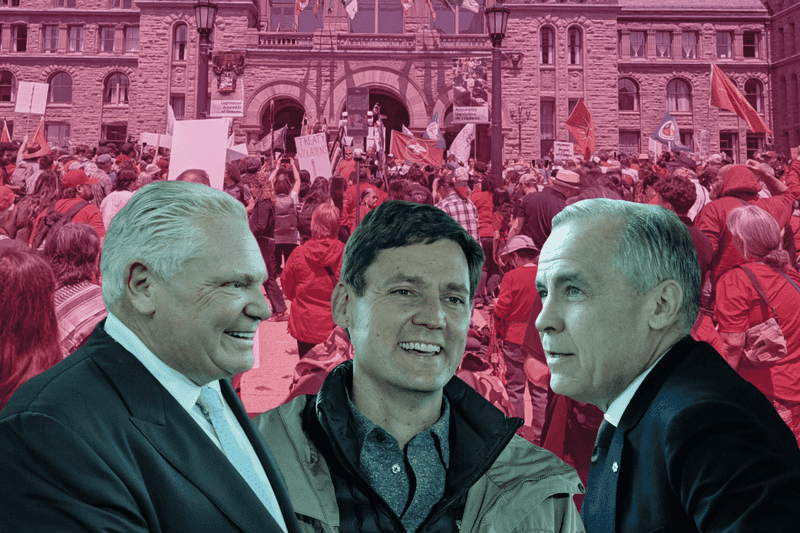
This essay is part of the series “A Vision of Debt Justice” of Progressive International’s Debt Justice Blueprint.
Public debt, when it is subject to the will of private lenders, is an engine of misery. It facilitates abusive cycles of poverty that deplete the resources of the destitute to fill the pockets of their creditors. But these cycles are the product of political decisions. This essay makes the simple argument that we have the power — and the urgent mandate — to shift the paradigm of public debt creation: from extraction in favour of the few to investment for the many.
Let’s begin by taking stock of the present paradigm, in which cuts to public spending are the default response to crises. The world has been brought to a halt by Covid-19. The last time something like this happened was the 2007-09 financial meltdown, a global crisis provoked by the over-extension of mortgages among the most precarious American households. What we learned from the governmental response to the crisis then is critical as we look to salvage our world today: forcing people into poverty while bailing out big banks and pushing up asset prices is a calculated political doctrine, not an economic fact of nature.
After the first round of emergency interventions in 2008 and 2009, governments rapidly transferred the burden of guilt to the public sector. They imposed a suite of austerity measures that decimated public services and welfare, and plunged already vulnerable populations into further poverty. As countries begin to emerge from the Covid-19 crisis, we see the pattern repeat: public spending cutbacks and regressive labour reforms.
Who Owes Whom?
A vicious project has been underway for the last four decades. It took shape in the 1970s as a counterrevolutionary response to the liberation movements of the era — from anticolonial struggles to rising worker militancy and gender- and race-based social movements seeking to test the redistributive limits of the Keynesian consensus.
This is the project of neoliberal capitalism. In its attempts to roll back the achievements of these movements, technocrats, beholden to powerful financial and corporate interests, increased inequality, devastated public services, and forced people to take on private debt as an alternative to depleted public investment.
Two guiding tenets shape neoliberal public finance; while contradictory in principle, they complement each other in practice. One preaches the virtue of balanced budgets and public spending restraint, the other that balanced budgets are an anachronism in an era of internationally integrated bond markets.
For this reason, neoliberal forces urge governments to prioritize marginal tax cuts and anti-inflation measures, even if they result in enormous public debt. During the 1980s, supply-side economists were some of the first to recognize that the US government would have no trouble financing Reagan’s spiraling public debt as long as it kept a tight lid on wage and consumer price inflation. The supply-siders were not averse to public spending; they merely specified that it should take the hidden form of regressive tax cuts rather than investment in redistributive public services such as health, education and welfare. Redistributive public investment, they argued, would push up wages and consumer prices and accordingly drive away would-be bond investors, whose asset positions move inversely with consumer price inflation. Tax incentives, by contrast, were designed to induce asset-price rather than wage- and consumer-price inflation, and were therefore more likely to find willing investors.
In practice, the collaboration between supply-side and public choice theories of public finance has come to mean this: while paying lip service to budget balance, governments routinely engage in extravagant acts of public spending, albeit in the hidden form of tax incentives that subsidize asset holders. The resulting deficits are invariably blamed on the redistributive public sector, which suffers a permanent process of downsizing and restructuring. As formerly public services such as education, health and welfare come under attack, their costs are transferred to households, where they are financed by unpaid labor and consumer debt. These forms of privatized obligation play out in predictably gendered ways, with women often bearing the burden of unpaid work and debt collateralization. In a curious inversion of “public” and “private” economics, households are now forced to take on increasing amounts of personal debt to pay for nominally public services, while private asset holders are multiply subsidized by tax incentives and preferences.
Much has been written recently about the connection between declining public investment in human services and ballooning household debt. Economists Aldo Barba and Massimo Pivetti have shown that even middle-income, asset-holding families have been forced to take on debt to maintain access to public or government-subsidized services such as education, health, and housing. This expanding debt burden has come to replace government deficit-spending as a stimulus to demand.
This predicament is sometimes referred to as “privatized Keynesianism,” but one must remember that personal debt is not the same for everyone: for those with existing assets, often acquired through inheritance, debt represents leverage and a means of further consolidating wealth; for the asset-poor, debt often represents a form of permanent servitude and a claim on future labor. While mortgage, credit card, medical, student and payday loans are the usual suspects here, we should also be attentive to the peculiar forms of debt that afflict the income- and asset-poor as a result of public service attrition. In the wake of the tax revolts that began in the 1970s, local and state governments have struggled to meet their mounting public service responsibilities because of a dwindling tax base. With many operating under constitutional tax and spending limits, local governments increasingly resort to fines, user fees and miscellaneous consumption charges as a way of maintaining public services.
Although by no means the most extreme case, the story of Ferguson, St. Louis, has thrown a media spotlight on local governments’ practice of using traffic fines and other penalties to generate revenue. The normalization of user charges for nominally public services—including within the criminal justice system—is a growing source of indebtedness among the asset-poor both in the United States and worldwide.
What is more, the resurgence of the US-based Black Lives Matter movement in the midst of the COVID-19 crisis, and its rapid spread worldwide, points to a new level of political awareness. At least since the 2014 protests in Ferguson, Missouri, the Black Lives Matter movement has foregrounded the connections between government spending cuts, household debt, and police violence. In cash-strapped cities such as Ferguson, Missouri, the police are more than so-called law enforcers; they are also tax collectors and bailiffs, whose job it is to collect revenue by meting out fines and punishing defaulters. As such, the Ferguson protests serve as a powerful example for those who would like to organize a wider movement around debt justice.
Since the 1970s, international financiers have been able to undercut the efforts of local, state and national governments to engage in a more democratic public investment by brandishing the threat of exit. When American workers, students and welfare mothers stepped up their militancy in the 1960s, threatening to erode both industrial profits and returns on financial assets, municipal bond financers fled New York City in search of more lucrative investment opportunities in the global South. When Federal Reserve Chairman Paul Volcker responded to this crisis by crushing the threat of wage inflation, the same investment funds came flooding back into US capital markets, simultaneously plunging the economies of the global South into a prolonged debt crisis.
Investment in the People
The question is clear: Why do governments borrow from private financial institutions in the first place, thereby setting themselves up to be disciplined by the bond market whenever their spending priorities become too democratic? The seeming inevitability of this subordination is reinforced by the semi-private nature of the central bank, along with the more recent dogma of monetary independence, which has empowered central banks to punish governments whenever their spending decisions risk raising wages. Today, central banks have long since given up their fight to suppress wage growth (they no longer have to), but their efforts to rescue the financial sector at any price has turned them into reliable generators of asset price inflation and intensified inequality.
- Socializing debt: We need to imagine how we might socialize or communalize public debt creation, such that every person becomes an owner and servicer of collective debt, holding an equal share in our collective future. Central banks need to be made democratically accountable again: beyond full employment, their mandate should be to grow the social wage and enable investment in collective infrastructures of existence, whether social or ecosystemic. Central banks should be doing all in their power to suppress asset price inflation and inflate social wages for both the employed and unemployed. We need public banks, not private banks, to lend to the Treasury and finance government bonds, so that governments are permanently liberated from the blackmail of private bondholders. Financial institutions, particularly public banks, need to move away from their current lending models that are focused on regressive revenue extraction and short-term profit-maximisation. Lending practices can be reoriented to meet public welfare by a push for long-term ‘patient’ lending and a more progressive system of taxation.
- Ending Punitiveness: In the United States, the long fiscal crisis of the state—manufactured by the steady withdrawal of federal funds, the tax revolt of the 1970s and a more punitive municipal bond market—has created a situation in which city and state governments accord greater priority to “public safety” than education or health care. Since the late 1970s, cities have increasingly resorted to regressive fines and fees as a way of covering their revenue shortfalls. Yet few people recognize such levies as alternative forms of taxation. We need to break these links — between regressive taxation, economic injustice and the punishment of the poor.
- Protecting the Public: Across the world have amassed financial resources and institutional capacity that is often captured by private interests or ends up best serving the needs of the asset-holding classes. But it doesn’t have to be this way: For example, states can obligate public banks to finance initiatives for green transitions, renewable and green energy resources, or equitable and energy-efficient public housing.
- Building a People’s Bank: The ability of international financiers to play off one country against another underscores the importance of developing an international solidarity around debt resistance. We must develop new mechanisms of international financial cooperation that curb the power of private credit markets and credit-rating agencies to discipline the public spending decisions of states. We still have a long way to go, but it is important to recognize the immensity of the task from the beginning: we cannot successfully or enduringly resist the localized discipline of privatized debt finance without resisting it elsewhere.
Melinda Cooper is a member of the Progressive International Debt Justice Collective. Melinda is Professor of Sociology at the Australian National University. She is the author of Family Values: Between Neoliberalism and the New Social Conservatism (2017) and is currently completing a monograph on the topic of neoliberal public finance.
From the Blueprint team at Progressive International
We live in a world of debt. The depth and breadth of global “debtification” is difficult to overstate. It is the primary contention of this collection that all these disparate dynamics — hedge funds raking in pandemic profits, students struggling to afford an education, micro-borrowers on the brink of bankruptcy — are different manifestations of the same basic structural mechanism at the heart of the global financial system: the endless cycle of privatized gains and socialized losses. Simply put, the rich get richer, while the poor, by design, remain poor.
The goal of this Collective is to end that cycle. Read the full Debt Justice Blueprint here. If you’re interested in engaging with us, please write to Varsha Gandikota-Nellutla at [email protected].



